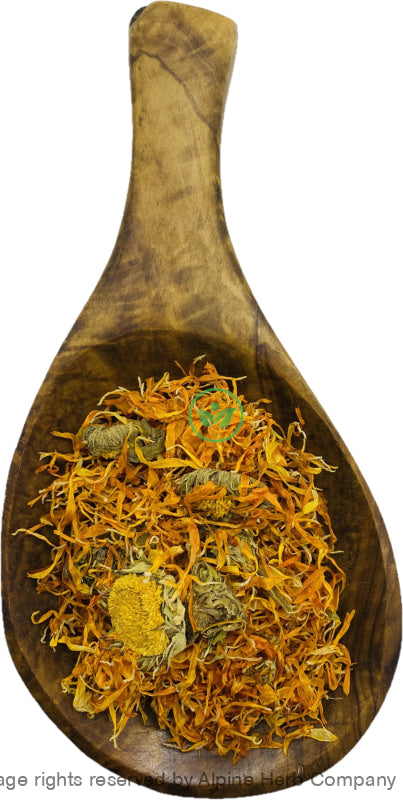Calendula Flower Whole (Marigold) Alpine Herb Company Inc.
$ 7,49 $ 4,49
Botanical Name: Calendula officinalis
Common Name:
- English: Marigold, Pot Marigold
- Unani: Zergul
- Also, known as: Pot marigold, Ringelblume, Souci des Jardins, Calendula, Calendola, Thulvkka Saamanthi, Calendule, English Garden Marigold, Fleur de Calendule, Fleur de Tous les Mois, Garden Marigold, Gold-Bloom, Holligold, Marybud, Pot Marigold, Souci des Champs, Souci des Jardins, Souci des Vignes, Souci Officinal, Zergul.
Origin: Egypt
Harvested: Cultivated
Parts Used: Whole Flower
General Information:
Calendula has been used for medicinal purposes since at least the 12th century. Flowers were used in ancient Greek, Roman, Middle Eastern, and Indian cultures as a medicinal herb as well as a dye for fabrics, foods, and cosmetics. Many of these uses persist today. Calendula officinalis is an aromatic herbaceous perennial plant, growing up to 90 cm in height.
Leaves are spirally arranged, 5-15 cm long, simple, and slightly hairy. The flower heads range from pastel yellow to deep orange, and are 3-5 cm across, with both ray florets and disc florets. Most cultivars have a spicy aroma. It is in flower from Jun to November, and the seeds ripen from Aug to November. The flowers are monoecious (individual flowers are either male or female, but both sexes can be found on the same plant) and are pollinated by Bees. It is noted for attracting wildlife. The plants will begin to flower in June and continue flowering until the frost kills them. They will increase from year to year if allowed to seed themselves. The ray florets are used and need quick drying in the shade, in a good current of warm air, spread out on sheets of paper, loosely, without touching each other, or they will become discolored. The Common Marigold is familiar to everyone, with its pale-green leaves and golden orange flowers.
One of the most versatile and important herbal medicines. This is the same Calendula as used by the homeopaths but the method of preparation and therapy is different. It contains high levels of nitrogen, phosphoric acid, and Vitamin A.
They are often used to add color to salads or added to dishes as a garnish and in lieu of saffron. A yellow dye has also been extracted from the flower, by boiling.
It should not be confused with plants belonging to the genus Tagetes, which are true marigolds and are also cultivated as garden plants commonly known as French or African marigolds.
How to use:
Hot Infusion:
The basic method for dried herbs and flower is, take 2-3 tablespoons of dried herb in a cup or teapot. Pour hot water over it and cover it with lid for 10-30 minutes. Hot water is needed to draw out the antioxidants, enzymes, vitamins, flavonoids and volatile oils from the botanicals. Strain and squeeze out as much as liquid as possible and enjoy!
Tips:
- You can sweeten your herbal tea with a bit of honey, natural fruit juice, stevia leaves powder and or licorice root powder.
- You can make ice cubes or pops by freezing tea in ice trays or pop molds.
Precautions:
You should consult with a qualified healthcare practitioner before using any herbal products, particularly if you are pregnant, nursing, or on any medications.
All information on this website is for educational purpose ONLY
This information has not been evaluated by Health Canada.
This information is not intended to diagnose, treat, cure, or prevent any disease.
| Unit Size | 100g, 200g, 400g, 1kg |
|---|
Prompt shipping and expert packing
Thanks to our longstanding association with UPS FedEx DHL as well as other leading global carriers, we can offer a variety shipping options. Our warehouse staff is highly trained and will be able to pack your goods in accordance with our precise and exact specifications. Your items will go through an exhaustive examination before they will be securely packaged before being delivered. We ship to hundreds of thousands of customers daily in different countries. This is a sign of our determination to become the largest online retailer worldwide. Warehouses and distribution centers are located throughout Europe as well as in the USA.
Note that orders containing multiple items are processed according to the particular item.
We will thoroughly inspect all items ordered before shipping. Most orders are shipped within 48 hours. The delivery time will be between 3 and 7 working days.
Returns
The stock market is always changing. It's not entirely managed by us since we're involved with several entities, including the factory and the storage. Therefore, the actual inventory could fluctuate at any moment. Please be aware that it is possible that your order could be out of stock after you've placed your order.
Our policy lasts for 30 days. If it's been more than 30 days since the date you purchased your item We're sorry to say that we can't offer you a full exchange or refund.
You can only return a product if it is unused and still in the same state as when you received it. The item should be in the original packaging.
Related products
Herb Whole
Herb Whole
Herb Whole
Herb Whole
Herb Whole
Herb Whole
Herb Whole
Herb Whole
Herb Whole
Herb Whole
Herb Whole
Herb Whole
Herb Whole
Herb Whole
Herb Whole



































